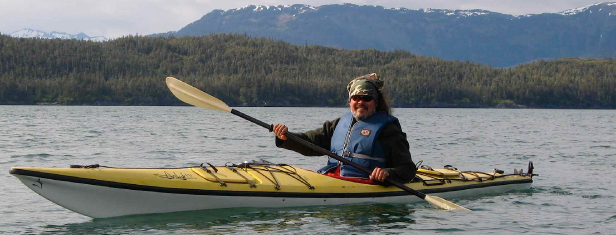Cordova, AK
Native Athabaskan Eyak fisherman from the Alaskan Copper River Delta and founder of Redzone, a First Nations project created in the wake of the 1989 Exxon Valdez oil spill

Dune is a native Athabaskan Eyak from the Copper River Delta of Alaska, and the founder of Redzone, an ongoing First Nations project created in the wake of the 1989 Exxon Valdez oil spill. He started the Copper River Wild Salmon Company to help local fishermen regain control over processing, packaging, labeling, and marketing their fish.
Q&A
What’s the Eyak connection to salmon?
Eyak means “flow to the lake.” The Eyaks set up villages where the lake becomes the river. Once salmon hit the lake, they change. Their meat turns white and their outer skin turns red. What a lot of people don’t realize is that salmon are forest animals. They are born in the forest, they go out to sea for two to seven years, and then come home to spawn and die. When we harvest salmon on the Copper River Delta, they are like torpedoes of energy. They have to have incredible strength to make it 300 miles upriver. That energy is passed on to us. When we share salmon with other people, that energy is passed on to them.
Why did you start Redzone?
I tried to get into politics right out of high school, but the Native Corporation rejected me. So I left to work on fisheries around the lower 48. Then the Exxon Valdez oil spill happened so I decided to form Redzone to protect the red salmon, the red people—the indigenous peoples—and places in peril.
Where were you when you found out about the spill?
I was in Arizona and had a really good day fishing when the phone rang. It was my sister, Pamela, who worked at the Eyak corporation headquarters in Cordova. The CEO told the staff, “The nation’s worst oil spill has happened in Prince William Sound, and we need to clear-cut as fast as we can while the eyes of the world are focused on the spill.” Pamela said, “Dune, you’d better come home and help us save our forest. Otherwise, we’re not going to have a fishery.” Tears just flowed from my eyes.
What happened after you returned?
There were approximately one million acres scheduled to be clear-cut along the parallel path of the Exxon Valdez spill, from Cordova to Kodiak. It was on Native land and all the clear cutting was being done by Native people. The environmentalists we knew were trying to lock up land so indigenous people couldn’t even fish. But when the oil spill happened, they were the only ones standing up against the largest corporation in the world.
What challenges are facing the wild salmon in the Copper River delta?
The glaciers are melting at unprecedented rates. The forests are drying up. Spruce bark beetles are moving in. There’s expanded tourism with more people and jet boats. Fewer wild fish make it into the spawning beds. There’s still no cap on the number of hatchery fish allowed. It literally costs tens and hundreds of millions of dollars to play god. The canneries basically own the salmon runs and control the price. Outside fishermen own more and more of the commercial fishing permits.
How do you approach all of this?
In the 20 years since the spill, our Eyak Preservation Council has taken on 30 frontline issues and won 28. We’re in the process of purchasing a coalfield on the Copper River delta watershed, and we’ve already stopped oil and gas drilling in Katalla. We’re helping form a Copper River Watershed Council made up of all the tribes along the river to develop a long-term strategic management plan. We also want to sit down with the government and push for salmon preservation legislation.
What are you working on now?
One of our goals is to create a sea-to-consumer model. Fishermen are getting $1.40 for Copper River sockeyes while consumers pay anywhere from $25 to $37 per pound. If fishermen sell direct, consumers pay less for a higher quality product, and fishermen make more money. There should be no more waste in the seafood industry. One filleted fish is 50 percent fish, 50 percent waste, and that waste is poured into sea, causing dead zones. Fish waste could be turned into organic fertilizer, fish meal, biodiesel, and omega-3 capsules. We want to help lead that change in turning waste into gold.
In our fishing community, having cold storage would build pride and empowerment. About a dozen additional communities have expressed their desire to have this as well. Cold storage increases the quantity of subsistence food as well as the quality. In this time of hardship, that’s huge.
In our fishing community, having cold storage would build pride and empowerment. About a dozen additional communities have expressed their desire to have this as well. Cold storage increases the quantity of subsistence food as well as the quality. In this time of hardship, that’s huge.



